Best Ice Caves in Iceland You Must Visit
Embark on a frosty journey to explore the ethereal beauty of Iceland’s ice caves, where nature’s artistry is frozen in time. This blog unveils the top ice caves in Iceland, each offering a unique, mesmerizing experience. From the shimmering blue arches of the Crystal Cave to the mystical depths of Katla, these icy wonders promise an adventure like no other.
Discover how these stunning formations change with the seasons, providing a new spectacle each visit. Learn essential tips for safe and respectful exploration of these fragile natural wonders. Whether you’re a seasoned explorer or a curious traveler, Iceland’s ice caves await to dazzle you with their serene, otherworldly charm. Join us as we guide you through these frozen marvels – a must-visit for every intrepid soul.
7 Best Ice Caves in Iceland
Embark on a thrilling journey to explore the ‘7 Best Ice Caves in Iceland,’ where nature’s frozen masterpieces await. Each cave offers a unique spectacle of glittering ice formations and deep blue caverns, providing an otherworldly experience. From the enchanting and famous caves to lesser-known hidden treasures, this guide uncovers Iceland’s most spectacular ice caves. Get ready to be captivated by their icy beauty and the stories they hold beneath the surface!
Vatnajökull Ice Cave
- Location: Vatnajökull National Park, Southeast Iceland
- Best Time to Visit: Winter (November to March) is the best time, as the caves are more stable and safely accessible.
Vatnajökull Ice Cave, located in Iceland, offers a mesmerizing journey into the heart of the country’s largest glacier, Vatnajökull. This natural wonder is a part of the Vatnajökull National Park, encompassing diverse landscapes from black sand beaches to rugged mountain ranges. The ice cave stands out as a stunning example of Iceland’s unique geological features.
The meltwater flow beneath the glacier forms the cave’s structure, creating an ever-changing network of tunnels and caverns. Visitors see a stunning array of ice formations when they enter the cave. These include transparent blue walls and detailed icicles hanging from the ceiling. The ice’s purity and depth create an ethereal blue light illuminating the cave, offering a surreal experience.
Visiting the Vatnajökull Ice Cave is a seasonal adventure, typically accessible from November to March when the ice is most stable. Guided tours provide safe access, highlighting the cave’s delicate ecosystem and the importance of preserving these natural treasures.
As a testament to Iceland’s volcanic activity, the cave also reveals layers of ash embedded within the ice, a record of historic eruptions. This feature adds to the cave’s allure, blending geological history with stunning visual beauty. The Vatnajökull Ice Cave is not just a tourist attraction but an immersive experience of Iceland’s dynamic natural world.
Crystal Ice Cave
- Location: Vatnajökull National Park
- Best Time to Visit: Accessible mainly in winter, especially from November to March.
The Crystal Ice Cave in Iceland, a hidden gem in the Vatnajökull Glacier, offers a unique glimpse into the world of ice caves. Best visited in winter (November to March), this cave is renowned for its extraordinary clarity and the enchanting play of light within its confines.
The cave’s main allure lies in its translucent ice walls, so clear they resemble crystal. This clarity is due to the age and purity of the ice, which is free from air bubbles. When sunlight penetrates the cave, it transforms the space into a luminous blue sanctuary, creating an ethereal atmosphere.
Smaller than other caves, the Crystal Ice Cave provides an intimate experience of the glacier’s beauty. Guided tours are essential for safety and offer insights into the glacier’s formation and the impact of climate change on these fragile ecosystems.
Visitors to the Crystal Ice Cave are treated to a magical experience, where nature’s artistry is displayed in pristine ice, making it a must-see destination for those seeking the extraordinary beauty of Iceland’s glacial landscapes.
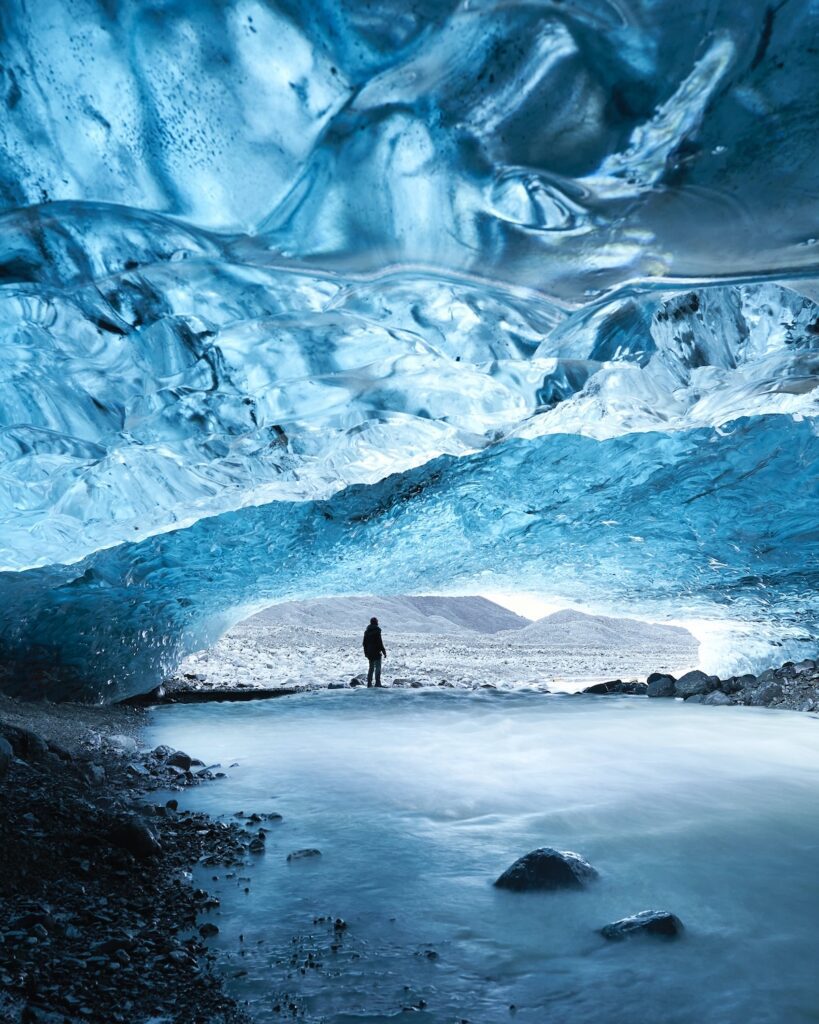
Katla Ice Cave
- Location & Features: Located under Kötlujökull Glacier, a part of Mýrdalsjökull glacier near Vik.
- Best Time to Visit: Unlike many other ice caves, Katla Ice Cave is accessible year-round, providing a unique opportunity to experience an ice cave outside the typical winter season.
Katla Ice Cave in Iceland, located near the mighty Katla Volcano, is a captivating natural phenomenon that offers a unique exploration experience. Accessible year-round, unlike many other ice caves, Katla Ice Cave is part of the Kötlujökull Glacier. This glacier drapes over one of Iceland’s most active volcanoes.
The cave stands out for its remarkable combination of ice and volcanic features. The cave’s interior presents a stunning array of colors, with shades of black, gray, and blue dominating the scene. This coloration directly results from the volcanic ash from Katla, which has been deposited over centuries, layering within the glacier’s ice.
Visitors traverse the cave and witness a dramatic contrast between the pure ice and ash layers, creating a visual spectacle. The cave’s structure, shaped by volcanic heat and glacial movement, changes subtly over time, offering a dynamic and ever-evolving landscape.
Guided tours are recommended for safety and to gain insights into the area’s geological history. The Katla Ice Cave experience is a journey through a unique blend of Iceland’s volcanic power and glacial beauty, making it an unmissable destination for those exploring the island’s natural wonders.
Langjökull Ice Cave
- Location: Langjökull Glacier, West Iceland
- Best Time to Visit: Open year-round.
The Langjökull Ice Cave, located within Iceland’s second-largest glacier, Langjökull, presents an extraordinary journey into a frozen wonderland. This artificial marvel, accessible throughout the year, offers a unique perspective on the majestic world of glacial ice.
Upon entering the cave, visitors are enveloped in a surreal landscape of icy tunnels and chambers. The walls and ceiling of the cave showcase layers of ice, revealing centuries of glacial history. The ice’s varying shades of blue, white, and sometimes even ash-gray tell a story of changing climates and volcanic eruptions.
What sets the Langjökull Ice Cave apart is its accessibility and the engineering feat it represents. The cave’s creation involved meticulously carving into the glacier, ensuring stability and safety for visitors. This has opened up a previously inaccessible world to most, providing an intimate experience with the heart of a glacier.
Guided tours offer insights into the glacier’s formation, the significance of glaciers in Iceland’s ecology, and the impact of climate change. Exploring the Langjökull Ice Cave is not just an adventure; it’s an educational journey that brings visitors face to face with the fragile beauty of Iceland’s icy landscapes.
Lofthellir Ice Cave
- Location: North Iceland, near Lake Mývatn
- Best Time to Visit: Summer, between May and October.
Lofthellir Ice Cave, a remarkable natural formation near Lake Mývatn in northern Iceland, offers a unique glimpse into the subterranean world of ice and lava. This cave is known for its extraordinary ice sculptures, formed over millennia, and is accessible mainly during summer.
The cave’s entrance, set in a rugged lava field, leads into a 370-meter-long lava tube. Inside, the cave reveals an astonishing array of ice formations. The stalactites and stalagmites made of ice come in various shapes and sizes, creating a mystical, otherworldly environment. The interplay between the cave’s volcanic origins and the ice formations results in a fascinating contrast, showcasing the diverse geological processes at work in Iceland.
Visiting Lofthellir Ice Cave involves a moderate hike and a crawl through the narrow cave entrance, making it an adventurous excursion. Once inside, the cave’s constant near-freezing temperature and the play of light on the ice create a surreal experience.
Guided tours provide essential safety equipment and valuable insights into the cave’s geological significance. Exploring Lofthellir Ice Cave is an unforgettable adventure, combining the thrill of caving with the awe-inspiring beauty of natural ice sculptures in a volcanic landscape.
Skaftafell Ice Cave
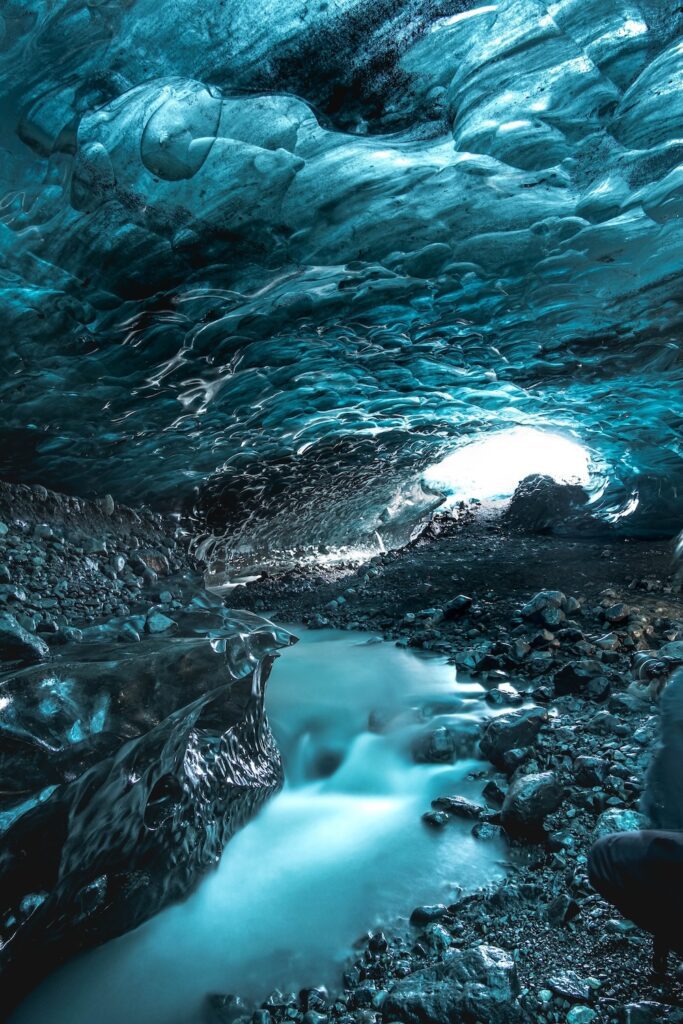
- Location: Skaftafell, part of Vatnajökull National Park
- Best Time to Visit: Winter months, primarily November to March.
The Skaftafell Ice Cave, nestled within the Vatnajökull National Park in Iceland, is a stunning natural formation that offers a glimpse into the dynamic world of glaciers. This cave is part of the enormous Skaftafell Glacier, a section of the Vatnajökull Glacier, Europe’s largest ice cap.
Characterized by its breathtaking blue ice, the Skaftafell Ice Cave forms each winter from the meltwater that refreezes, creating new and unique formations each year. The translucent blue walls, sculpted by the flow of water and the pressure of glacial movements, create a surreal, otherworldly environment that captivates visitors.
Accessible mainly during the winter months, from November to March, when the ice is most stable, the cave offers a safe and awe-inspiring experience under the guidance of expert tours. These guided expeditions not only ensure safety but also provide:
- Insights into the cave’s formation.
- The life cycle of glaciers.
- The impacts of climate change on these fragile ecosystems.
Exploring the Skaftafell Ice Cave is like stepping into a frozen wonderland, where the natural artistry of ice creates an unforgettable visual spectacle, making it a must-visit destination for those seeking to experience the unique beauty of Iceland’s glacial landscapes.
Raufarholshellir Lava Tube
- Location: Close to Reykjavik, South Iceland
- Best Time to Visit: Accessible all year, with guided tours available for a comprehensive experience.
Raufarhólshellir, one of Iceland’s most extended and renowned lava tubes, presents a distinctive geological experience, differing from the typical ice caves in the country. Located a short drive from Reykjavik, it’s easily accessible, making it a popular destination for tourists and locals.
Formed during a volcanic eruption about 5,000 years ago, Raufarhólshellir is a magnificent example of the natural architecture created by flowing lava. As the outer layers of the lava stream cooled and solidified, the molten lava continued to flow underneath, leaving behind a hollow tunnel. Stretching over 1.3 kilometers in length and reaching up to 30 meters wide in places, the lava tube is adorned with various rock formations, including stalactites and shelves of hardened lava.
The cave’s interior reveals a palette of colors, with shades of red, yellow, and black, resulting from the different mineral deposits in the rock. Light beams entering through ceiling collapses create a dramatic and mystical atmosphere inside the tunnel.
Guided tours offer safe exploration and insights into the cave’s formation, Iceland’s volcanic activity, and the lava tube’s unique ecosystem. Raufarhólshellir provides a fascinating glimpse into the volcanic forces that have shaped Iceland’s dramatic landscape.
Are Ice Caves in Iceland Worth It?
Visiting ice caves in Iceland is an experience that is undoubtedly worth it for those seeking a unique blend of adventure and natural beauty. These caves, formed within glaciers or as lava tubes, present a world of stunning blue ice, intricate formations, and a glimpse into the heart of Iceland’s dynamic geology.
Each cave offers something different: from the crystal-clear walls of the Crystal Ice Cave, the volcanic ash layers in Katla Ice Cave, and the artificial marvel of Langjökull. The accessibility of these caves varies, with some open year-round and others only during winter, adding to the allure of a time-sensitive adventure.
Besides the visual spectacle, ice caves provide educational insights into the impact of climate change on glaciers, making it a thought-provoking experience. Whether for photography, exploration, or understanding Iceland’s unique landscape, visiting these ice caves is a memorable and worthwhile endeavor, adding depth and wonder to any Iceland adventure.
What’s the Difference Between Ice Caves and Glacier Caves?
Ice and glacier caves in Iceland are two distinct natural phenomena, each with its unique charm. Ice caves are caves that contain significant amounts of ice year-round. They can form in various locations, not just in glaciers. These caves often have ice formed by water seeping in and freezing or from outside snow that drifts into the cave and then freezes. The result is a magical world of sparkling ice in all shapes and sizes, often illuminated by a mesmerizing blue light.
On the other hand, glacier caves are formed explicitly within the body of a glacier. They occur when meltwater, often from the glacier’s surface, carves out tunnels and caverns within the ice. These caves are dynamic and constantly changing. As the glacier moves and shifts, so does the shape and size of the cave. This makes glacier caves particularly fascinating, as they directly reflect the ever-changing nature of glaciers.
Both ice caves and glacier caves in Iceland offer breathtaking experiences. While ice caves stun visitors with their year-round ice formations and sometimes vivid colors, glacier caves provide a rare glimpse into the heart of a glacier, revealing the ongoing processes of glacial melt and movement. Exploring these caves is not just an adventure; it’s a journey into the heart of Iceland’s unique and extraordinary natural world.
 Which Month Is the Best to Visit Ice Caves in Iceland?
Which Month Is the Best to Visit Ice Caves in Iceland?
The best month to visit ice caves in Iceland is usually November to March. During these months, it’s winter in Iceland. This time is significant because the weather is cold enough to make the ice in the caves stable and safe.
The ice is at its best in these months, especially from December to February. The caves are more solid, and you can see the beautiful blue ice. It’s a magical experience with the ice shining and the caves looking like a different world.
But remember, the weather in Iceland can be unpredictable. Always check with tour guides before you go. They know the best and safest times to visit the caves.
Visiting ice caves is a particular part of seeing Iceland. Going into these winter months, you’ll see something unique. Just be sure to dress warmly!
Are Ice Caves in Iceland Safe?
Ice caves in Iceland can be safe, but it’s essential to be careful. The safety of these caves depends on the time of year and the weather. The best and safest time to visit is during the winter months, from November to March. This is when the ice is most stable and robust.
Even in winter, it’s always best to go with a guide. Guides know the caves well. They can tell you which parts are safe and which aren’t. They also learn about any recent changes in the caverns.
Remember, ice caves can change fast. The weather and the temperature can make the ice move or melt. That’s why checking with a guide is so important. They keep an eye on the caves and the weather.
So, yes, ice caves in Iceland can be safe if you visit at the right time and with a guide who knows the area. Always listen to their advice to enjoy the caves safely.
Do I Need Any Special Equipment for the Ice Caves?
When visiting ice caves in Iceland, you do need some special equipment. First, you’ll need good hiking boots. The ground in the caves can be slippery and uneven. Good boots will help you walk safely.
Next, you’ll need a helmet. The caves can have low ceilings or falling ice, so a helmet keeps your head safe. You’ll also need a headlamp. The caves can be dark inside, and a headlamp helps you see clearly.
Warm clothes are a must. It’s cold inside the caves, so dress in layers. Remember a warm hat and gloves, too.
Some tours might give you equipment like crampons. Crampons attach to your boots and help you walk on the ice without slipping.
Always check with your tour guide about what they provide and what you should bring. They will tell you precisely what you need for a safe and fun visit to the ice caves.
Enjoy Ice Caves in Iceland with Deluxe Iceland’s Premium Yet Affordable Services
Enjoy the stunning ice caves in Iceland with Deluxe Iceland’s premium and affordable services. We offer unique tours to these beautiful caves and make sure your trip is comfortable, safe, and unforgettable.
Our tours take you to the best ice caves in Iceland. You’ll see amazing blue ice and incredible ice formations. We plan everything, so you don’t have to worry. We also provide all the special gear you need, like helmets and crampons, to make your walk in the caves safe and easy.
The guides from Deluxe Iceland are experts. They know a lot about the caves and will tell you interesting facts. They also know how to keep you safe in the caverns.
With Deluxe Iceland, you can explore Iceland’s ice caves in a unique, and high-quality way. Contact us today to get started planning your Ice cave tour in Iceland.
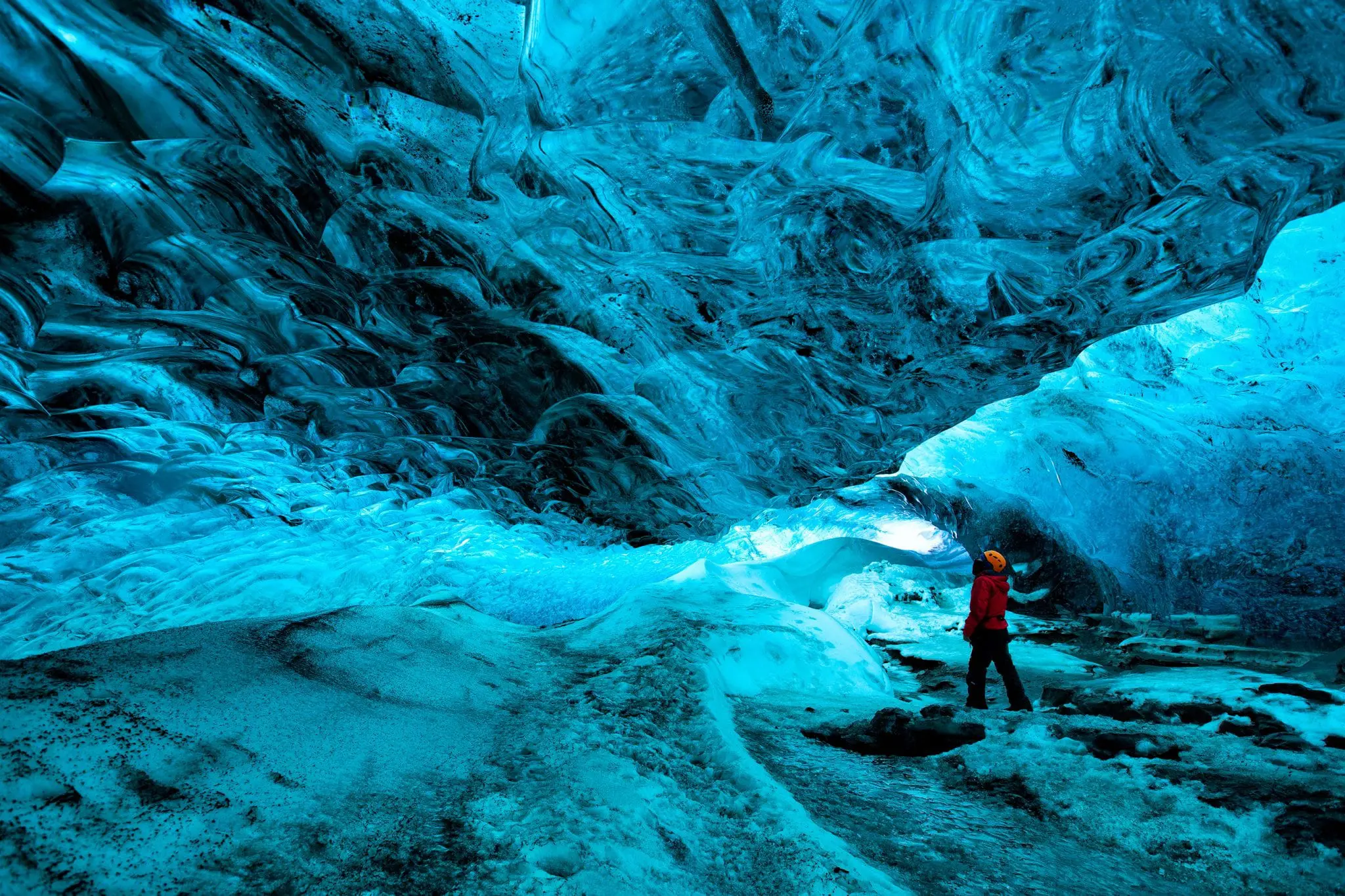

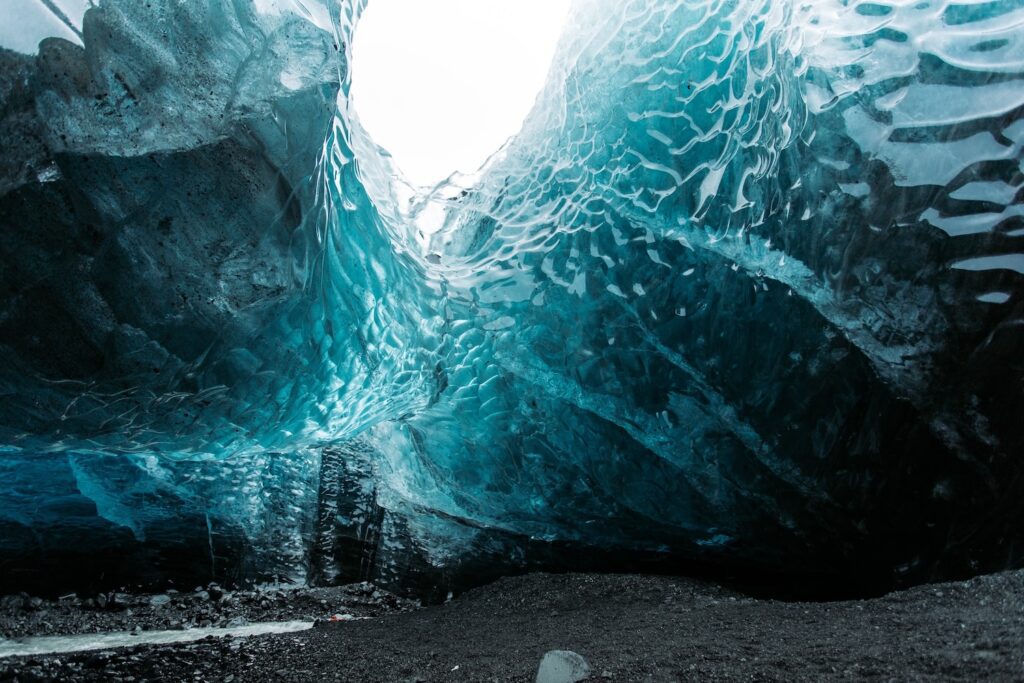
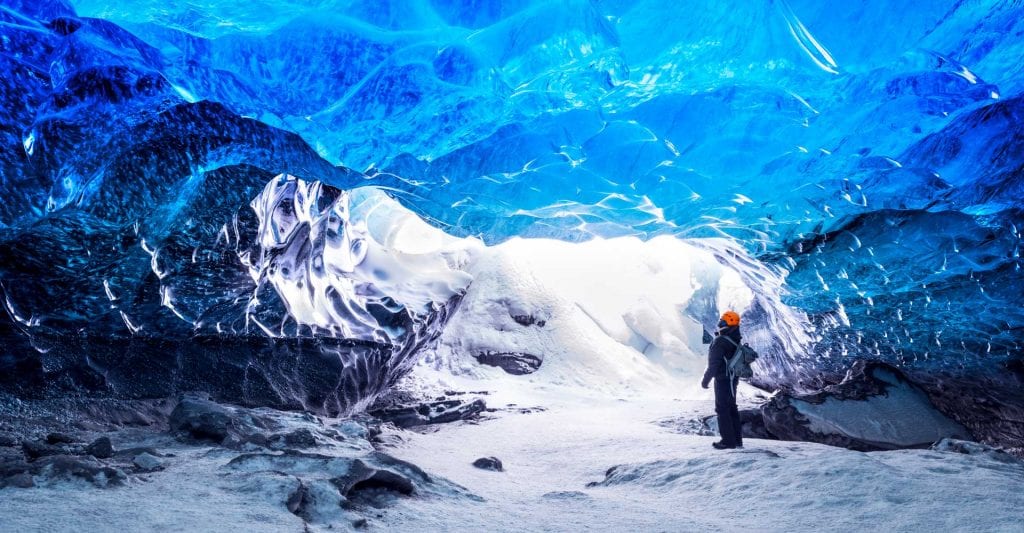 Which Month Is the Best to Visit Ice Caves in Iceland?
Which Month Is the Best to Visit Ice Caves in Iceland?